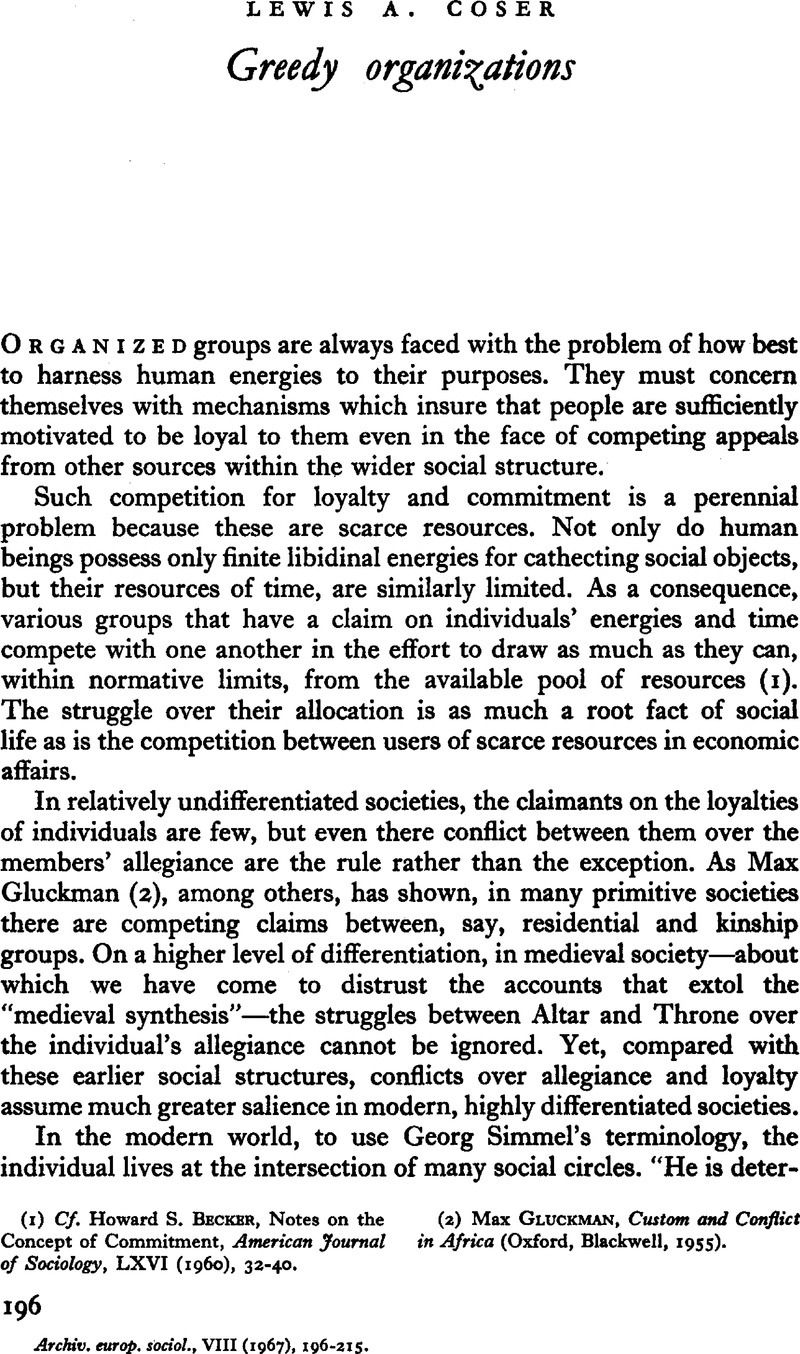Article contents
Abstract

- Type
- Research Article
- Information
- European Journal of Sociology / Archives Européennes de Sociologie , Volume 8 , Issue 2 , November 1967 , pp. 196 - 215
- Copyright
- Copyright © Archives Européenes de Sociology 1967
References
(1) Cf. Becker, Howard S., Notes on the Concept of Commitment, American Journal of Sociology, LXVI (1960), 32–40.CrossRefGoogle Scholar
(2) Gluckman, Max, Custom and Conflict in Africa (Oxford, Blackwell, 1955).Google Scholar
(3) Simmel, Georg, Conflict and the Web of Group-Affiliations, transl. by Wolff, Kurt H. and Bendix, Reinhard (New York, The Free Press, 1955), p. 150.Google Scholar
(4) Coser, Lewis A., The Political Functions of Eunuchism, American Sociological Review, XXIX (1964), pp. 880–885.CrossRefGoogle Scholar
(5) Cf. also Hopkins, Keith, “Eunuchs in Politics in the Later Roman Empire”, Proceedings of the Cambridge Philological Society, 189 (New Series No. 9) (1963), PP. 62–80.CrossRefGoogle Scholar
(6) Coser, , op. cit. p. 885.Google Scholar
(7) Lea, Henry Charles, History of Sacerdotal Celibacy in the Christian Church3 (New York, Macmillan, 1907), Vol. I, pp. 60—63.Google Scholar
(8) Ibid. p. 137 and Jones, A. H. M., The Later Roman Empire (Oxford, Blackwell, 1964), Vol. II, p. 929.Google Scholar
(9) Lea, , op. cit. Vol. I, p. 167.Google Scholar
(10) Jones, , op. cit. Vol. II, p. 927.Google Scholar
(11) Lea, , op. cit. Vol. I, p. 44.Google Scholar
(12) Ibid. Vol. I, p. 408.
(13) Ibid. Vol. I, pp. 408–409. Cf. also Mirbt, Carl, Die Publizistik im Zeitalter Gregors VII (Leipzig, Hinrichssche, 1894), p. 339.Google Scholar
(14) Mirbt, , op. cit. p. 337.Google Scholar
(15) Ibid. p. 337.
(16) Schaff, Philip, History of the Christian Church (Grand Rapids, Mich., Erdmans, 1960 [originally published in 1907]), Vol. V, p. 37.Google Scholar
(17) Flick, Alexander C., The Rise of the Medieval Church (New York, Burt Franklin, n.d. [originally published in 1909]), p. 453.Google Scholar
(18) Fliche, Augustin, La Réforme grégorienne (Paris, Champion, 1924), Vol. I, p. 211.Google Scholar
(19) Emerton, Ephriam (ed.), The Correspondence of Pope Gregory VII (New York, Columbia University Press, 1932).Google Scholar See also Mirbt, and Flick, , op. cit.Google Scholar
(20) The above is quoted almost verbatim from Tellenbach, Gerd, Church, State, and Christian Society at the Times of the Investiture Contest (Oxford, Blackwell, 1940), pp. 129–130.Google Scholar
(21) Glock, Charles and Stark, Rodney, Religion and Society in Tension (Chicago, Rand McNally, 1965), p. 52.Google Scholar
(22) Simmel, , op. cit. pp. 144–146.Google Scholar
(23) Chavard, F., Le Célibat des prêtres et ses conséquences (Genève, J. Benoit, 1874), p. 360.Google Scholar
(24) Houtin, Albert, Courte kistoire du cilibat ecclésiastique (Paris, Rieder, 1929), p. 253.Google Scholar
(25) Cf. Jager, Abbé, Le Célibat ecclésiastique2 (Paris, Gaume, 1836), p. 121.Google Scholar
(26) Mgr Pavy, Louis-Antoine-Augustin, Du Célibat ecclésiastique2 (Paris, Jacques Lecoffre, 1852), p. 346.Google Scholar
(27) Sambuga, Joseph Anton, Schuzrede für den ehelosen Stand der Geistlichen (Frankental, Ludwig Gegel, 1782), pp. 35–36 and 51–52.Google Scholar
(28) Anon, Bruder was hälts du wohl von dem Verbote der Priester-Ehe oder von dem ehelosen Leben der Mönchen, Nonnen, Ordens- und Weltpriester in der römischkatholischen Kirche? (Vienna 1782), pp. 98–99.Google Scholar
(29) Coser, , Op. cit.Google Scholar
(30) Manuel, Frank E., “Toward a Psychological History of Utopia” in Manuel, Frank E. (ed.), Utopias and Utopian Thought (Boston, Houghton Mifflin, 1966), p. 70.Google Scholar
(31) Noyes, John Humphrey, History of American Socialisms (New York, Hillary House, 1961 [first published in 1870]), p. 147.Google Scholar
(32) Slater, Philip, On Social Regression, American Sociological Review, XXVIII, (1963), pp. 339–364.CrossRefGoogle Scholar
(33) Nordhoff, Charles, The Communistic Societies in the United States (New York, Schocken Books, 1965 [first published in 1875]), p. 276.Google Scholar
(34) Bittner, Egon in his “Radicalism and the Organization of Radical Movements”, American Sociological Review, XXVIII (1963), p. 938Google Scholar, makes a similar point. Cf. also Vladimir Nahirny, C., Some Observations on Ideological Groups, American Journal of Sociology, XLVII (1962), 397–4O5.CrossRefGoogle Scholar
(35) Noyes, , op. cit. p. 140.Google Scholar
(36) Webber, Everett, Escape to Utopia (New York, Hastings House, 1959), pp. 288–289Google Scholar, and Holloway, Mark, Heavens on Earth (New York, Library Publishers, 1951), p. 172.Google Scholar
(37) Noyes, , op. cit. p. 626.Google Scholar
(38) Noyes, , op. cit. pp. 634–635.Google Scholar Brackets in the original.
(39) Noyes, , op. cit. pp. 143–145.Google Scholar
(40) Green, Calvin and Wells, Seth (eds.), A Summary View of the Millenial Church or United Society of Believers2 (Albany, N.Y., 1848), pp. 276–277.Google Scholar
(41) Hinds, William A., American Communities and Cooperative Colonies, rev. ed., (Chicago, Charles H. Kerr, 1902), p. 187.Google Scholar
(42) Duss, John S., The Harmonists (Harrisburg, The Pennsylvania Book Service, 1943), pp. 28–29.Google Scholar On closely related developments in the Israeli Kibbutz, cf. Talmon, Yonina, “The Family in a Revolutionary Movement—The Case of the Kibbutz in Israel”, in Nimkoff, M. F. (ed.), Comparative Family Systems (Boston, Houghton Mifflin, 1965), pp. 259–286.Google Scholar
(43) Merton, Robert K., Social Theory and Social Structure (New York, The Free Press, 1957), pp. 319 sqq.Google ScholarCoser, Rose Laub, Insulation from Observability and Types of Social Conformity, American Sociological Review, XXVI (1961), 28–39.CrossRefGoogle Scholar
(44) Coser, R. L., loc. cit. p. 28.Google Scholar
(45) Nordhoff, , op. cit. pp. 145–146.Google Scholar
(46) Andrews, Edward D., The People Called Shakers (New York, Oxford University Press, 1953).Google Scholar
(47) Nordhoff, , op. cit. pp. 289–290.Google Scholar
(48) Ibid. p. 291.
(49) Ibid. pp. 292–293.
* A slightly revised version of this paper was presented to the first meeting of the Massachusetts Sociological Society at Clark University, Worcester, Mass., in March 1967.
(50) A number of the themes adumbrated here are more fully developed in an honor's thesis of a student of mine, Levine, Harry G., The Structure of Utopia: A Sociological Analysis of Five American Communistic CommunitiesGoogle Scholar (available at the Brandeis University Library, Waltham 54, Mass.).
- 27
- Cited by




